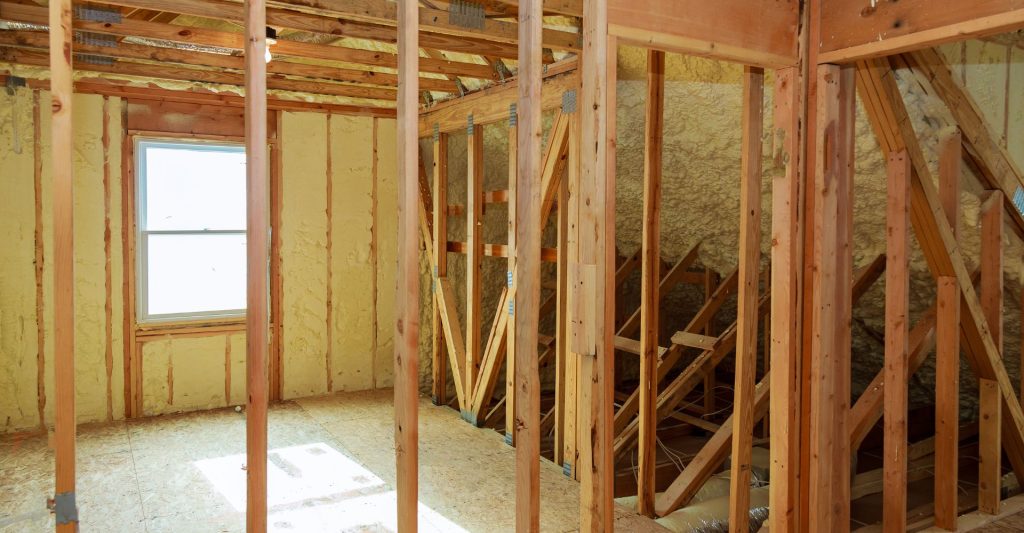- 927 Lee Road 268, Valley, AL
- 256-790-9771
Spray Foam Insulation Attic Insulation Services by Pro Insulations
Radiant Barrier Insulation in East Alabama & West Georgia: Reduce Cooling Costs & Improve Energy Efficiency
Radiant Barrier Insulation in East Alabama & West Georgia: Reduce Cooling Costs & Improve Energy Efficiency
What are Radiant Barriers?
Radiant barriers are installed in homes — usually in attics — primarily to reduce summer heat gain and reduce cooling costs.
Radiant barriers consist of a highly reflective material that reflects radiant heat rather than absorbing it. They don’t, however, reduce heat conduction like thermal insulation materials
Radiant barriers consist of a highly reflective material that reflects radiant heat rather than absorbing it. They don’t, however, reduce heat conduction like thermal insulation materials

Make the jump to energy efficiency today!
Spray foam insulation is the best choice for energy efficient insulation in your new or existing home.
Call us today
How they work:

Heat travels from a warm area to a cool area by a combination of conduction, convection, and radiation. Heat flows by conduction from a hotter location within a material or assembly to a colder location, like the way a spoon placed in a hot cup of coffee conducts heat through its handle to your hand. Heat transfer by convection occurs when a liquid or gas — air, for example — is heated, becomes less dense, and rises. As the liquid or gas cools, it becomes denser and falls. Radiant heat travels in a straight line away from any surface and heats anything solid that absorbs its energy.
Most common insulation materials work by slowing conductive heat flow and — to a lesser extent — convective heat flow. Radiant barriers and reflective insulation systems work by reducing radiant heat gain. To be effective, the reflective surface must face an air space. Dust accumulation on the reflective surface will reduce its reflective capability. The radiant barrier should be installed in a manner to minimize dust accumulation on the reflective surface.
When the sun heats a roof, it’s primarily the sun’s radiant energy that makes the roof hot. Much of this heat travels by conduction through the roofing materials to the attic side of the roof. The hot roof material then radiates its gained heat energy onto the cooler attic surfaces, including the air ducts and the attic floor. A radiant barrier reduces the radiant heat transfer from the underside of the roof to the other surfaces in the attic.
Make the jump to energy efficiency today!
Spray foam insulation is the best choice for energy efficient insulation in your new or existing home.
Call us today
When Should You Need a Radiant Barrier?
A radiant barrier works best when it is perpendicular to the radiant energy striking it. Also, the greater the temperature difference between the sides of the radiant barrier material, the greater the benefits a radiant barrier can offer.
Radiant barriers are more effective in hot climates than in cool climates, especially when cooling air ducts are located in the attic. Some studies show that radiant barriers can reduce cooling costs 5% to 10% when used in a warm, sunny climate. The reduced heat gain may even allow for a smaller air conditioning system. In cool climates, however, it’s usually more cost-effective to install more thermal insulation than to add a radiant barrier.
Radiant barriers are more effective in hot climates than in cool climates, especially when cooling air ducts are located in the attic. Some studies show that radiant barriers can reduce cooling costs 5% to 10% when used in a warm, sunny climate. The reduced heat gain may even allow for a smaller air conditioning system. In cool climates, however, it’s usually more cost-effective to install more thermal insulation than to add a radiant barrier.
Types of Radiant Barriers:

Radiant barriers consist of a highly reflective material, usually aluminum foil, which is applied to one or both sides of a number of substrate materials such as kraft paper, plastic films, cardboard, oriented strand board, and air infiltration barrier material.
Some products are fiber-reinforced to increase durability and ease of handling.
Radiant barriers can be combined with many types of insulation materials in reflective insulation systems. In these combinations, radiant barriers can act as the thermal insulation’s facing material.
Frequently Asked Questions
How do radiant barriers work?
Radiant barriers reduce radiant heat transfer by reflecting heat away from the attic instead of letting it absorb into your home. Unlike traditional insulation, which slows heat conduction, radiant barriers focus on blocking heat radiation.
What are the benefits of installing a radiant barrier?
- Lowers attic temperatures
- Reduces cooling costs (by 5% to 10% in hot climates)
- Improves overall home energy efficiency
- May allow for a smaller air conditioning system, saving even more energy
Where are radiant barriers typically installed?
Radiant barriers are most commonly installed in attics, either:
- Under the roof decking
- Draped over attic insulation
- Attached to rafters or trusses
Do radiant barriers replace traditional insulation?
No. Radiant barriers do not replace thermal insulation but complement it by reducing heat gain through radiation. For best results, they should be used alongside materials like spray foam or cellulose insulation.
Are radiant barriers effective in all climates?
Radiant barriers are most effective in hot climates, especially when cooling ducts are in the attic. In colder climates, additional thermal insulation is usually a better investment.
